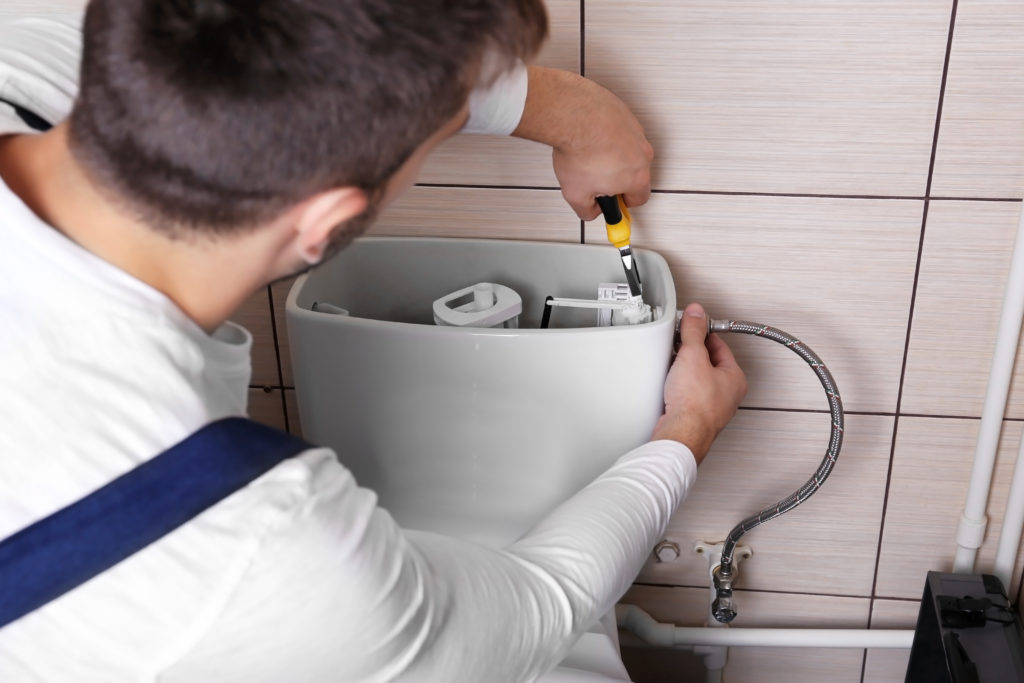Clink. Clang.
Clatter, clatter, clatter.
Flick.
Grrr. Gurgle.
Ca-chunk, ca-chunk, ca-chunk.
Crunch.
Silence.
Does this sequence of sounds (and the deafening silence after they stop) seem familiar? Then you may have already experienced a clogged garbage disposal unit in your home. Ugh. 😩
We know how annoying this problem can be, so we won’t waste any time with unnecessary information up here. Instead, let’s dive into our step-by-step homeowners guide on how to unclog a garbage disposal—and stop yourself from breaking it again—before you try your hand at fixing your own.
What’s Causing Your Clogged Garbage Disposal?
First things first, you’ll want to find out what exactly is clogging up your garbage disposal. This will help you fix the current problem at hand and ensure you keep your garbage disposal clear from improper food, debris, and foreign objects in the future.
A few examples of items and actions that can clog garbage disposals include:
Incorrect Food Types
One common mistake homeowners make with garbage disposals is thinking they can throw anything down there, but that’s simply not true. While your garbage disposal unit can handle an impressive range of soft and hard food waste, there are a few items that can cause clogs, including:
- Eggshells 🍳
- Potato peels 🥔
- Coffee grounds ☕️
- Banana peels 🍌
- Clam and oyster shells 🦪
- Corn husks 🌽
- Citrus peels 🍊
- Artichokes 🥗
- Hot grease or oil 🛢
Grinding any of these items above could leave you with a clogged garbage disposal.

Non-Food Items
We can tell you from personal experience that it is not a fun fix when non-food items fall down your garbage disposal unit. After accidentally grinding up a souvenir shot glass from a recent spring break trip, it took hours to collect tiny shards of glass from the sink drain. Like we said, not fun at all.
In addition, forks, knives, spoons, and other foreign objects that are small enough to get into your garbage disposal mouth might also be what’s clogging things up.
Too Much Food, Too Fast
Another way garbage disposals get clogged is when too much food waste is fed into them at once. You want to send things down the drain slowly and in separate chunks so the drain pipes stay clear. When used correctly, your garbage disposal should only need replacing every ten years, according to American Home Shield. Still, if you continue feeding it incorrectly, it could clog up much sooner.
Leaving Behind Leftover Waste
Many homeowners also make the mistake of leaving their food waste behind to build up instead of using sufficient water to wash it down the drain pipe. You should always run cold water for at least one minute after dumping your waste down the garbage disposal unit to ensure it’s not stuck since leaving standing water and waste like potato peels or other food particles in the catch bucket can create a starchy paste that leads to even further problems.
Water Temperature
You might not realize it, but the temperature of the water used to rinse down your garbage disposal matters too. Always use cold water when rinsing down food waste, and run hot water while cleaning your garbage disposal.
Lack of Water Flow
As you might guess, you also need to use running water, in general, to ensure everything actually gets down your garbage disposal. Like we mentioned, the best temperature to wash debris down the drain is cold, but you can use hot water to clean the garbage disposal. Keep your water running for one minute after dumping waste down the disposal to ensure no loose debris, stringy fibers, or foreign objects bind to the inside of the garbage disposal.
Fixing a Garbage Disposal Clog in 7 Simple Steps
Now that you know what the culprit is causing this frustrating clogged garbage disposal, you can start taking steps to solve the issue. You won’t need any fancy power tools, an oddly-sized allen wrench, or hard-to-find materials; just a plunger, cleaning products, the hex wrench your garbage disposal came with, and probably a bit of elbow grease on your part.
So, with that said, roll up your sleeves and get ready to get down and dirty as you learn how to unclog a garbage disposal.
1) Shut Off Power and Unplug the Disposal Unit
Start by shutting off power to the garbage disposal unit and unplugging it. This is a critically important step that ensures your hands and fingers will be completely safe during the unclogging process. The last thing you want is to take a trip to the emergency room when you were just trying to fix your clogged garbage disposal — that would be painful and expensive.

2) Inspect the Garbage Disposal for Debris
Next, look inside the garbage disposal with a flashlight to see if there is any visible debris. If you spot something sticking up, such as a spoon or other foreign object, you can try to simply pull the item out with tongs or pliers. With the electrical power shut down, this should be entirely safe.
3) Apply a Natural Cleaner
If the item or items clogging your garbage disposal aren’t obvious, you can also try flushing the device with a natural cleaner to dislodge any buildup of food particles. A simple DIY solution for drain cleaning you can make with items from around the house is a combination of white vinegar and baking soda. Combine:
- 1/2 cup of white vinegar
- 1/4 cup of baking soda
Pour the mixture down your drain trap and let it sit for 20-30 minutes. Then, you can start flushing water down the disposal. This is when you’ll want to use hot water instead of cold, and ensure you use enough water to flush the drain pipes completely.
4) Plunge the Drain
Now, if the natural cleaner doesn’t fix your clog, you can try a different method to remove the debris. Tough clogs can be cleared by placing a plunger directly into your sink against the garbage disposal opening.
Just as you would use a plunger to unclog a toilet, you can use one to unclog a garbage disposal. Simply move the plunger handle up and down and allow the suction this movement creates to do the rest.
This is typically considered a last resort, as the other steps above should do the trick to free up your drain clog, but it can be a necessary evil for homeowners with sinks that experience frequent clogs.
5) Manually Spin the Disposal Blades
With the electrical power shut down, you can also take time to clear out the garbage disposal blades, called the impeller blades. Use your fingers or a long, blunt tool to spin the blades around so anything stuck can be dislodged and fall down the drain. If your impeller blades are broken, you can find replacement parts at a local home improvement store.
6) Clean the P-Trap
Another area where debris might get stuck is underneath your sink in the P-trap. The P-trap is the first curved pipe you see that sends your waste through the trap arm, which is the straight part connecting your garbage disposal to the local sewer system. See how it works below:
If anything is stuck in your drain pipe, you’ll need to use a hex wrench, also referred to as an allen wrench, to take the pipes apart and manually remove the debris. You might already have an allen wrench in your toolbox, or your garbage disposal could have also come with one upon purchase.
Disconnect the P-trap arm from the other pipes at the trap adapter. If you have plastic parts, you might even be able to do this step without a wrench using your hands. Once the pipes are disconnected, inspect the P-trap arm for anything that might be causing the clog and remove it.
7) Put Everything Back Together
With your garbage disposal system cleared, you can start cleaning up and putting everything back together. Turn the main power panel back on, hit the reset button on the bottom of your garbage disposal, and give it a whirl while you flush more hot water down the drain.
This will be the final flush before you switch back to cold water. When everything’s said and done, the clog in your garbage disposal should be clear.
Tips for Keeping Garbage Disposals Clean
Whether you experience frequent clogs or you just prefer to keep things running clean and smooth in your sink, you can try to avoid clogs by deploying these helpful tips:
- Read the instruction manual thoroughly
- Don’t just throw anything down the garbage disposal
- Buy a sink drain strainer
- Chop food waste into smaller bits before disposal
- Feed waste down the disposal unit at a slow pace
- Use cold water to rinse down your garbage disposal drain
Call Us to Clear Your Clogged Garbage Disposal
Are you still struggling to unclog a garbage disposal in your home even after reading this in-depth how-to guide? We get that DIY home improvements aren’t for everybody and don’t want you to drop any more silverware down the drain trying to fix it yourself. We’re here to help ensure that the job is done right without wasting any time and losing any forks—or fingers. 😱
Put your trust in AJ Alberts for all of your plumbing needs. Contact us now to get your garbage disposal unit unclogged and so much more.







